
The pin-tailed sandgrouse is a medium large bird in the sandgrouse family. It has a small, pigeon like head and neck and a sturdy, compact body. It has long pointed wings, which are white underneath, a long tail and a fast direct flight. Flocks fly to watering holes at dawn. The call is a loud kattar-kattar. This gregarious species breeds on dry open treeless plains and similar habitats. Its nest is a ground scrape into which two or three cream-coloured eggs with cryptic markings are laid. Both sexes incubate the eggs.

The bay duiker, also known as the black-striped duiker and the black-backed duiker, is a forest-dwelling duiker native to western and southern Africa. It was first described by British zoologist John Edward Gray in 1846. Two subspecies are identified. The bay duiker is reddish-brown and has a moderate size. Both sexes reach 44–49 cm (17–19 in) at the shoulder. The sexes do not vary considerably in their weights, either; the typical weight range for this duiker is 18–23 kg (40–51 lb). Both sexes have a pair of spiky horns, measuring 5–8 cm (2.0–3.1 in). A notable feature of this duiker is the well-pronounced solid stripe of black extending from the back of the head to the tail.

The Conopidae, usually known as the thick-headed flies, are a family of flies within the Brachycera suborder of Diptera, and the sole member of the superfamily Conopoidea. Flies of the family Conopidae are distributed worldwide in all the biogeographic realms except for the poles and many of the Pacific islands. About 800 species in 47 genera are described worldwide, about 70 of which are found in North America. The majority of conopids are black and yellow, or black and white, and often strikingly resemble wasps, bees, or flies of the family Syrphidae, themselves notable bee mimics. A conopid is most frequently found at flowers, feeding on nectar with its proboscis, which is often long.

The black-headed grosbeak is a medium-sized, seed-eating bird in the family Cardinalidae. It is sometimes considered conspecific with the rose-breasted grosbeak with which it hybridizes on the American Great Plains.

The peninsular rock agama or South Indian rock agama is a common species of agama found on rocky hills in south India. An allied species, Psammophilus blanfordanus, is found in the Eastern Ghats, but north of the range of this species.

Volucella zonaria, the hornet mimic hoverfly, is a species of hoverfly. These flies are capable of buzz pollination.
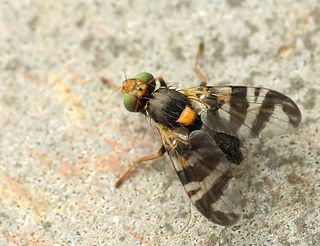
Rhagoletis cerasi is a species of fruit fly in the family Tephritidae.
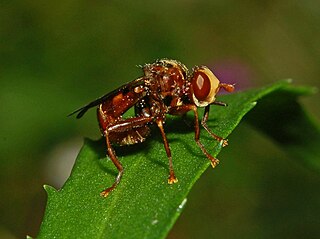
Sicus ferrugineus is a species of fly from the genus Sicus in the family Conopidae.

Conops quadrifasciatus, the yellow-banded conops, is a species of fly from the genus Conops in the family Conopidae.

Myopa is a genus of flies from the family Conopidae.
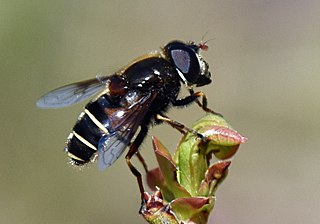
Eristalis cryptarum is a holarctic species of hoverfly. Known as the bog hoverfly or bog-dwelling drone fly, it is a bog specialist but may occur in other wetlands. Its larvae are assumed to live in peat that is saturated with water, such as that found in these boggy areas. The female has been observed depositing eggs on and close to very fresh cow dung along oligotrophic seepages in moorland.

Trichopoda pennipes is a species of feather-legged fly in the dipteran family Tachinidae.
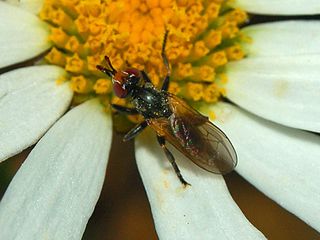
Thecophora atra is a species of small fly in the family Conopidae subfamily Myopinae.

Thecophora pusilla is a species belonging to the family Conopidae subfamily Myopinae.

Cylindromyia brassicaria is a species of fly in the family Tachinidae.
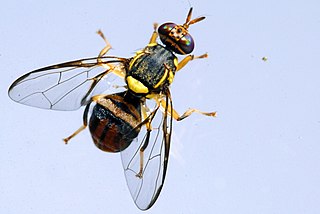
Bactrocera (Bactrocera) invadens is the name given to tephritid fruit flies that were introduced to East Africa from Sri Lanka and subsequently invaded practically the whole of Sub-Saharan Africa, hence the species name "invadens". It was first shown to be the same biological species as B. dorsalis s.s. by possessing identical sex pheromonal components after consumption of methyl eugenol, and also based on CO1 and rDNA sequences. Subsequently, it was agreed that B. invadens, B. papayae and B. philippinensis be synonymized as B. dorsalis. To counteract its detrimental effects to the fruit business, the industry resorts to cold treatment in order to get rid of the larvae.

Andrena scotica, the chocolate mining bee or hawthorn bee, is a species of mining bee from the family Andrenidae. It occurs in western Europe and is one of the most frequently encountered mining bees found in Great Britain, where it had been previously misidentified as Andrena carantonica.

Eristalis anthophorina, the orange-spotted drone fly, is a species of syrphid fly with a Holarctic distribution. It is a common fly in wetlands, including bogs, fens, and woodland pools. In North America, it occurs throughout much of Canada and primarily in the northern parts of the United States. It may be introduced in North America.

Physocephala tibialis is a species of thick-headed fly found throughout the eastern United States, often near flowering plants. The adult fly is primarily black with a yellow face and thin white stripes on the abdomen. It is commonly found along the east coast of the United States and is often found near flowering plants.

Eristalis brousii, the hourglass drone fly, is a species of syrphid fly largely eliminated in most of its former range except in northern Canada. It was first officially described by Williston in 1882. The adults are also known as flower flies because they are commonly found around and on flowers from which they get both energy-giving nectar and protein-rich pollen. The larvae are aquatic filter-feeders of the rat-tailed type.





















